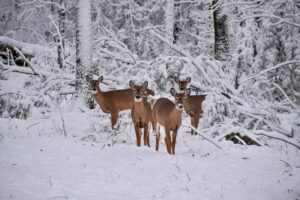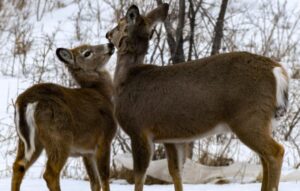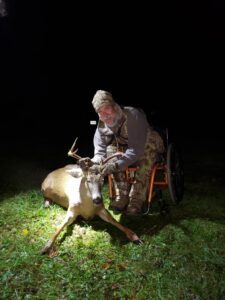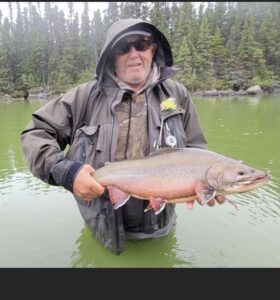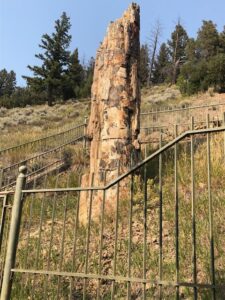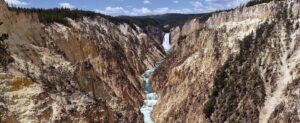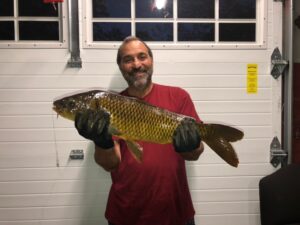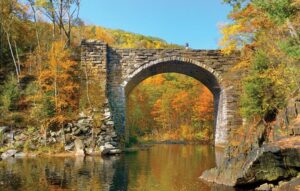Shotgun deer hunting season opens on November 29 and runs through Saturday, December 11. Hunters are allowed to take two bucks, and if they were awarded an antlerless deer permit, they can take one of them too. Shotgun, archery, and muzzleloader implements are allowed. Be sure you are familiar with all of the deer hunting regulations listed on pages 26 through 29 of the abstracts.
Also, the shotgun (third) season for bear hunting opens on November 29 and also runs through December 11. Regulations governing that season are listed on pages 30 through 31 of the abstracts.
All rabbit, hare, squirrel and furbearer hunting seasons are closed during shotgun deer hunting season except for coyotes. The pheasant, grouse and wild turkey seasons are closed for the year as are the migratory goose and woodcock seasons. The duck hunting season closes during the first week of shotgun deer season but in the Berkshire Zone reopens on December 6 through year end.
Hunters who are coming out of the woods after hunting hours, (1/2 hour after sunset) must unload everything, bullets, arrows, bolts, etc., because they are considered hunting after hours, which is illegal. The sunset time during the shotgun deer hunting season is around 4:15 pm.
No hunting allowed on Sunday.
Mandatory Deer checking
Don’t forget, during the first week of the shotgun deer season (November 29–December 4), all harvested deer must be brought to a physical check station within 48 hours so MassWildlife biologists can collect biological data. Online harvest reporting is NOT available during this time. Hunters may recall that last year physical checking was not mandatory, due to Covid.
Western District Check Stations open Monday-Saturday:
Ernie’s Auto Sales – North Adams
Papa’s Healthy food and Fuel – Otis
Mill River General Store – Mill River
Lee Sportsmen’s club – Lee
B&D Variety – Huntington
Western District Office – Dalton
Hunter Harassment Law
Mass General Law, Part I, Title XIX, Chapter 131, Section 5C states “No person shall obstruct, interfere with or otherwise prevent the lawful taking of fish or wildlife by another at the locale where such activity is taking place”. It then lists 7 specific types of violations. “Environmental protection officers and other law enforcement officers with arrest powers shall be authorized to enforce the provisions of this section.”
Real cases of hunter harassment (meaning those that actually target specific hunters or their equipment and prevent, interfere or obstruct them from hunting) should be reported to Massachusetts Environmental Police statewide dispatch at 1-800-632-8075.
Precious Memories
Well, here we go again, another sleepless night thinking about opening day of shotgun deer hunting on Monday morning. Sleep will be out of the question and I’ll probably do the same thing I do every year……. toss and turn all night waiting for the 4:00 am alarm to go off. Thoughts of previous opening days will undoubtedly cross my mind, one after another. I’ll remember the rainy, foggy, snowy cold days. I’ll remember each time I erred and allowed a big buck to get away. Yes, and remember a few nice deer that didn’t get away.
In my early deer hunting days, (beginning in 1957), deer hunting season opened the first Monday of December and ran only one week ending on that Saturday. There were no archery of primitive hunting seasons back then extending the season from mid-October through the last day of December (like it is today). As usual, I’ll remember the people with whom I hunted over those years. Sadly, many of them have since passed away. I’ll remember the gun that I used on my first deer hunt, an Ithaca 12-gauge side by side shotgun. It was a smooth bore gun which shot slugs or buckshot. It wasn’t until years later that the Ithaca Deerslayer shotguns (with rifled barrels) were allowed.
Our deer hunting clothes consisted mainly of black and red checkered wool coats (preferably Woolrich, if you could afford it). Later on, as I recall, solid red hunting pants and coats came into vogue. There was no such thing as fluorescent red color, (but they were experimenting with bright colors when I went into the service). My oldest and now deceased brother Joe bought me a hunting outfit when I was a teenager and, get this, its color was bright yellow/bright red. It was reversable. When I returned home from the service in 1967, the State had settled on the fluorescent red color (or blaze orange, if you prefer) and deer hunters were required to wear 500 inches of it on your chest, back and head (still required).
I remember well at the end of the days during deer week Joe driving us around the neighborhoods of other deer hunters checking to see if they had a field dressed deer hanging from a tree in their yards or open garages. That was common back then and they would sometimes hang them out there for a week, The theory being that by hanging them that long, the muscles would break down, and the aging was supposed to make the meat more tender and taste better. The winters seemed colder back then and the likeliness of the meat spoiling was less than today. I suspect some of the hunters hung them out there just to show them off. You can’t do that now. What with the bears and coyotes around these days, you would be lucky to find the hooves remaining the next morning after hanging them up. And you didn’t have to worry about neighbors complaining about the sight of a dead deer hanging from a tree, it was common practice.
To keep our hands warm while hunting, many of us used Joni hand warmers. We smelled like walking Zippo cigarette lighters in the woods as they were fueled by lighter fluid. If you got them to work properly, you could stick them in your pocket and they would stay warm all day. They had a little hole in the side of them so that you could light up a cigarette if you so desired. Now, of course, there are throw-away hand warmers, heated by chemical reaction and not by smelly fuel.
I was always cold deer hunting in those days, especially my feet because they would inevitably get wet from sweat or leaky boots. It wasn’t until the Sorel boots came out with their felt linings that I could finally feel my toes while hunting.
Of course, there was no such thing as GPS or cell phones. We had to rely on our compasses. Many a time that old compass saved the day for me. No one used backpacks like today. You carried your food, thermos, drag rope, ammo, knife, etc., in your pockets, coat pouch or attached to your belt.
As I recall, there was only one deer checking station and that was at the DFW headquarters in Pittsfield. It wasn’t until later that various checking stations were established.
Your license had to be displayed, usually inside a clear plastic pouch, pinned to your coat.
Deer hunters came to the Berkshires by the droves from all over and traffic lined up coming off of the turnpike. Diners opened up early in the mornings. Motels were filled as were our local watering holes at the end of the day. Campers were parked in various places in our state forests. Visiting hunters brought millions of dollars to the Berkshire economy.
There was much more hunting land available for locals and for the non-residents to get lost in
Most older teens took opening day off from school. It was pretty much expected and usually the school officials simply looked the other way.
Oh, and there was another thing. Every deer hunting season, starting with the Tuesday issue of the Berkshire Evening Eagle newspaper and running until the end of the season, editor/columnist Ted Giddings listed the daily deer kills, giving the hunter’s name, whether it was a doe or buck, its weight, number of points and the town where it was shot.
Aah, the memories.
Lying sleepless in bed, it’s at times like these when I understand the lyrics of that old gospel song written by J. B. F. Wright: “Precious memories” as the song goes, “how they linger. How they ever flood my soul. In the stillness, of the midnight, precious sacred scenes unfold.”

